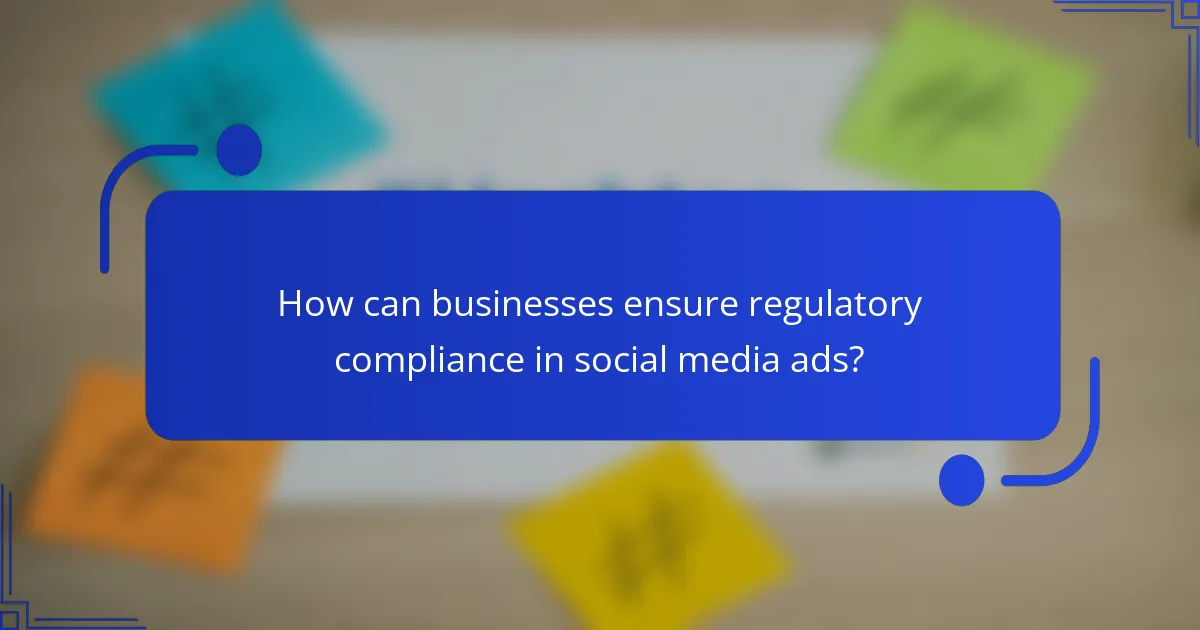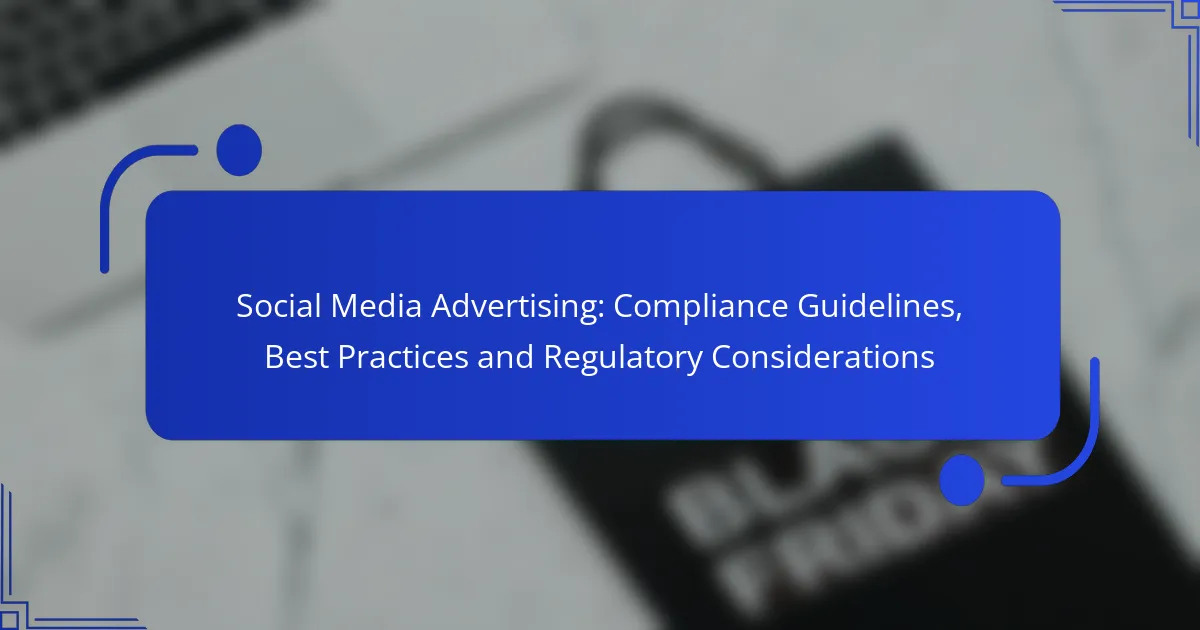Social media advertising presents unique opportunities and challenges, particularly regarding compliance with federal regulations and platform-specific policies. Advertisers must prioritize transparency and consumer privacy while crafting engaging content that adheres to best practices. By implementing regular audits and providing training, businesses can navigate the regulatory landscape effectively and enhance their advertising strategies.

What are the compliance guidelines for social media advertising in the US?
Compliance guidelines for social media advertising in the US require adherence to various federal regulations and platform-specific policies. Advertisers must ensure transparency, protect consumer privacy, and avoid misleading claims to maintain compliance.
Federal Trade Commission (FTC) regulations
The FTC enforces regulations that mandate truthfulness in advertising. Advertisers must clearly disclose any material connections with endorsers and avoid deceptive practices that could mislead consumers. For instance, if a social media influencer is paid to promote a product, they must disclose this relationship to their audience.
Failure to comply with FTC guidelines can result in significant penalties, including fines and legal action. Advertisers should regularly review their content to ensure it meets these standards, particularly when using endorsements or testimonials.
Children’s Online Privacy Protection Act (COPPA)
COPPA imposes strict rules on the collection of personal information from children under 13 years old. Advertisers targeting this demographic must obtain verifiable parental consent before collecting any data. This includes any advertising practices on social media platforms that may appeal to younger audiences.
To comply with COPPA, businesses should implement age-gate mechanisms and ensure that their marketing strategies do not inadvertently target children without proper safeguards. Regular audits of content and audience targeting can help maintain compliance.
Platform-specific advertising policies
Each social media platform has its own set of advertising policies that must be followed. For example, Facebook and Instagram have guidelines regarding prohibited content, including misinformation and hate speech, which advertisers must adhere to when creating campaigns.
Advertisers should familiarize themselves with the specific rules of each platform they use, as violations can lead to ad disapproval or account suspension. Regularly checking for updates to these policies is essential, as platforms frequently revise their guidelines to address new challenges and trends in advertising.

What best practices should be followed for social media advertising?
To maximize effectiveness, social media advertising should adhere to best practices that enhance engagement and compliance. Key strategies include understanding your target audience, crafting clear calls-to-action, and optimizing visual content.
Target audience segmentation
Effective social media advertising begins with precise target audience segmentation. Identify demographics such as age, gender, location, and interests to tailor your messages and increase relevance. Utilize tools like Facebook Insights or Google Analytics to gather data on your audience’s behavior.
Consider creating buyer personas to visualize your ideal customers. This approach helps in crafting personalized content that resonates with specific segments, ultimately improving conversion rates.
Clear call-to-action strategies
A clear call-to-action (CTA) is essential for guiding users toward desired actions, such as making a purchase or signing up for a newsletter. Use direct language and actionable phrases like “Shop Now” or “Learn More” to prompt immediate responses.
Position your CTA prominently within your ads and ensure it stands out visually. Testing different CTAs can help determine which resonates best with your audience, leading to higher engagement and conversion rates.
Visual content optimization
Visual content plays a crucial role in social media advertising, as it captures attention and conveys messages quickly. Use high-quality images or videos that align with your brand and appeal to your target audience. Aim for a resolution that looks good on both desktop and mobile devices.
Incorporate branding elements consistently across visuals to enhance recognition. Additionally, consider A/B testing different images or video formats to identify what drives the most engagement and conversions.

How can businesses ensure regulatory compliance in social media ads?
Businesses can ensure regulatory compliance in social media ads by implementing regular audits, providing training for marketing teams, and consulting with legal experts. These practices help identify potential issues and ensure adherence to relevant advertising regulations.
Regular audits of advertising content
Conducting regular audits of advertising content is crucial for maintaining compliance. These audits should evaluate whether ads adhere to legal standards and platform-specific guidelines. A good practice is to schedule audits quarterly or biannually to catch any discrepancies early.
During audits, businesses should check for misleading claims, inappropriate content, and adherence to age restrictions. Creating a checklist can streamline this process, ensuring all aspects are reviewed consistently.
Training for marketing teams
Training marketing teams on compliance issues is essential for effective social media advertising. Regular workshops can help staff understand the latest regulations and platform policies, reducing the risk of non-compliance. Aim for training sessions at least twice a year to keep the team updated.
Include case studies and examples of compliant and non-compliant ads in training materials. This practical approach helps team members recognize potential pitfalls and encourages adherence to best practices.
Consultation with legal experts
Consulting with legal experts ensures that advertising strategies align with current laws and regulations. Engaging legal counsel can provide insights into specific compliance requirements, especially for industries with stringent regulations, such as finance or healthcare.
Consider establishing a relationship with a legal advisor who specializes in advertising law. Regular consultations can help businesses navigate complex regulations and avoid costly legal issues down the line.

What are the consequences of non-compliance in social media advertising?
Non-compliance in social media advertising can lead to significant financial and reputational repercussions for businesses. Companies may face fines, damage to their brand image, and even suspension of their advertising accounts on various platforms.
Fines from regulatory bodies
Regulatory bodies can impose fines on companies that fail to adhere to advertising standards and guidelines. These fines can range from hundreds to thousands of dollars, depending on the severity of the violation and the jurisdiction. For instance, in the European Union, non-compliance with the General Data Protection Regulation (GDPR) can result in penalties of up to 4% of a company’s annual global turnover.
To avoid fines, businesses should familiarize themselves with local advertising laws and ensure that their campaigns comply with these regulations. Regular audits of advertising practices can help identify potential compliance issues before they escalate.
Reputation damage
Non-compliance can severely damage a brand’s reputation, leading to loss of customer trust and loyalty. Negative publicity from compliance failures can spread quickly on social media, resulting in a backlash against the brand. For example, a company caught misleading consumers in their advertising may face public outrage and calls for boycotts.
To protect their reputation, businesses should prioritize transparency in their advertising efforts. Clear communication about products and services, along with adherence to ethical advertising practices, can help mitigate potential damage.
Account suspension on platforms
Social media platforms have strict advertising policies, and non-compliance can lead to account suspension or banning. This can halt all advertising efforts and limit a company’s ability to reach its audience. For example, repeated violations of Facebook’s advertising policies can result in a permanent ban from the platform.
To prevent account suspension, businesses should regularly review the advertising policies of each platform they use. Implementing a compliance checklist before launching campaigns can help ensure that all ads meet platform requirements and reduce the risk of suspension.

What are the key metrics for measuring social media advertising success?
The key metrics for measuring social media advertising success include return on ad spend (ROAS), engagement rates, and conversion rates. These metrics provide insights into the effectiveness of advertising campaigns and help marketers optimize their strategies.
Return on ad spend (ROAS)
Return on ad spend (ROAS) measures the revenue generated for every dollar spent on advertising. A higher ROAS indicates a more effective campaign, typically aiming for a ratio of at least 4:1, meaning four dollars earned for every dollar spent.
To calculate ROAS, divide the total revenue from the ad campaign by the total ad spend. For example, if you spend $1,000 on ads and generate $5,000 in revenue, your ROAS would be 5. This metric helps businesses assess the financial efficiency of their advertising efforts.
Engagement rates
Engagement rates reflect how well your audience interacts with your content, including likes, shares, comments, and clicks. High engagement rates often indicate that your content resonates with your target audience, which is crucial for brand awareness and loyalty.
To calculate engagement rate, divide the total engagement actions by the total reach or impressions, then multiply by 100 to get a percentage. A typical engagement rate for social media ads can range from 1% to 5%, depending on the platform and industry.
Conversion rates
Conversion rates measure the percentage of users who take a desired action after interacting with your ad, such as making a purchase or signing up for a newsletter. A higher conversion rate signifies that your ads effectively drive users to complete these actions.
To calculate conversion rate, divide the number of conversions by the total number of visitors from the ad, then multiply by 100. A good conversion rate in social media advertising typically falls between 2% and 5%, but this can vary based on the industry and campaign goals.

What emerging trends are shaping social media advertising compliance?
Emerging trends in social media advertising compliance are largely driven by increasing regulatory scrutiny and evolving consumer expectations. Advertisers must adapt to these changes to ensure their campaigns remain effective and legally compliant.
Increased focus on data privacy
Data privacy has become a central concern for social media advertisers, influenced by regulations like the General Data Protection Regulation (GDPR) in Europe and the California Consumer Privacy Act (CCPA) in the United States. Advertisers must prioritize transparency in data collection and usage to build trust with consumers.
To comply with data privacy regulations, businesses should implement clear consent mechanisms, allowing users to opt-in for data collection. Regular audits of data practices can help identify potential compliance issues before they escalate.
Common pitfalls include failing to update privacy policies or neglecting to inform users about data usage. Advertisers should regularly review their compliance strategies and consider using privacy-focused tools to enhance user trust.
